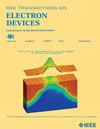基于12-in - 55nm CMOS晶圆级电性测试的硅化镍系统研究
IF 2.9
2区 工程技术
Q2 ENGINEERING, ELECTRICAL & ELECTRONIC
引用次数: 0
摘要
硅化镍的质量可以极大地影响CMOS器件,从而影响芯片的性能,特别是对于具有较小节点的技术。由于现在的芯片通常由大量器件组成,由于缺陷形成的概率很大,仅研究少数单个器件很难检测其影响。因此,晶圆尺度的研究是必要的,以获得缺陷形成的整体影响,但很少报道。本文通过在对缺陷高度敏感的55纳米CMOS技术生产的12英寸晶圆上进行SRAM阵列的电子晶圆映射测试,系统地研究了各种制造工艺对硅化镍质量的影响。发现Siconi (Trademark)预清洗和第二阶段快速热退火(RTA)具有较大的工艺窗口;而Ni - pt薄膜的薄厚度和/或第一阶段RTA的高温会极大地促进Ni侵蚀缺陷的形成,这是由于过量的热收支增强了Ni向Si缺陷的扩散。通过优化硅化工艺,可以有效抑制Ni侵蚀的形成,获得低泄漏电流(平均值为7.97\times 10^{{3}}$ pA)和均匀分布(标准差为8.58\times 10^{{3}}$ pA)的SRAM阵列,将1M SRAM良率大幅提高到97.18%,即使在行业技术中也是突出的。该系统的研究可以为工业晶圆规模上的缺陷形成提供有价值的见解,可以指导小节点CMOS技术的高性能欧姆接触的发展。本文章由计算机程序翻译,如有差异,请以英文原文为准。
Systematic Study of Nickel Silicide Based on Wafer-Scale Electrical Testing in 12-in 55 nm CMOS Technology
Nickel silicide quality can greatly influence the CMOS devices and hence chip performances, especially for the technology with smaller nodes. As chips nowadays are normally composed of a huge number of devices, the influence is difficult to be detected by studying a few individual devices due to the probability of defect formation. Thus, wafer-scale investigation is necessary to obtain the overall impact of defect formation, which is however rarely reported. Here, the effect of various fabrication processes on the quality of Ni silicide is investigated systematically by electrical wafer mapping tests of SRAM arrays on 12-in wafers produced by 55 nm CMOS technology that are highly sensitive to defects. It is found that the Siconi (Trademark) precleaning and the 2nd stage rapid thermal annealing (RTA) have a large process window; while the thin thickness of Ni–Pt film and/or the high temperature of 1st stage RTA can greatly promote the Ni encroachment defect formation, which is due to the excess thermal budget that enhances the diffusion of Ni to the Si defects. With the optimization of silicidation process, the formation of Ni encroachment can be effectively suppressed, and the leakage current of SRAM arrays with low (mean value of $7.97\times 10^{{4}}$ pA) and uniform distribution (standard deviation of $8.58\times 10^{{3}}$ pA) is obtained, and 1M SRAM yield is largely increased to 97.18%, which is outstanding even among the industry technology. This systematic study can provide valuable insight into the defect formation on industrial wafer scale, which can guide the development of high-performance Ohmic contact for CMOS technology with small nodes.
求助全文
通过发布文献求助,成功后即可免费获取论文全文。
去求助
来源期刊

IEEE Transactions on Electron Devices
工程技术-工程:电子与电气
CiteScore
5.80
自引率
16.10%
发文量
937
审稿时长
3.8 months
期刊介绍:
IEEE Transactions on Electron Devices publishes original and significant contributions relating to the theory, modeling, design, performance and reliability of electron and ion integrated circuit devices and interconnects, involving insulators, metals, organic materials, micro-plasmas, semiconductors, quantum-effect structures, vacuum devices, and emerging materials with applications in bioelectronics, biomedical electronics, computation, communications, displays, microelectromechanics, imaging, micro-actuators, nanoelectronics, optoelectronics, photovoltaics, power ICs and micro-sensors. Tutorial and review papers on these subjects are also published and occasional special issues appear to present a collection of papers which treat particular areas in more depth and breadth.
 求助内容:
求助内容: 应助结果提醒方式:
应助结果提醒方式:


